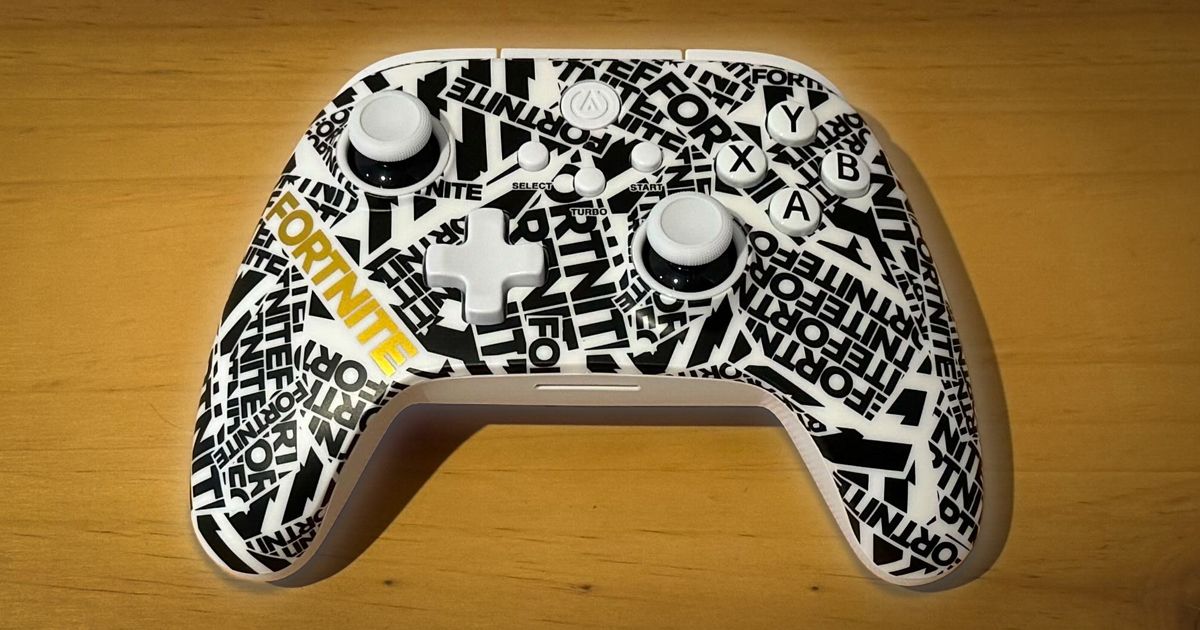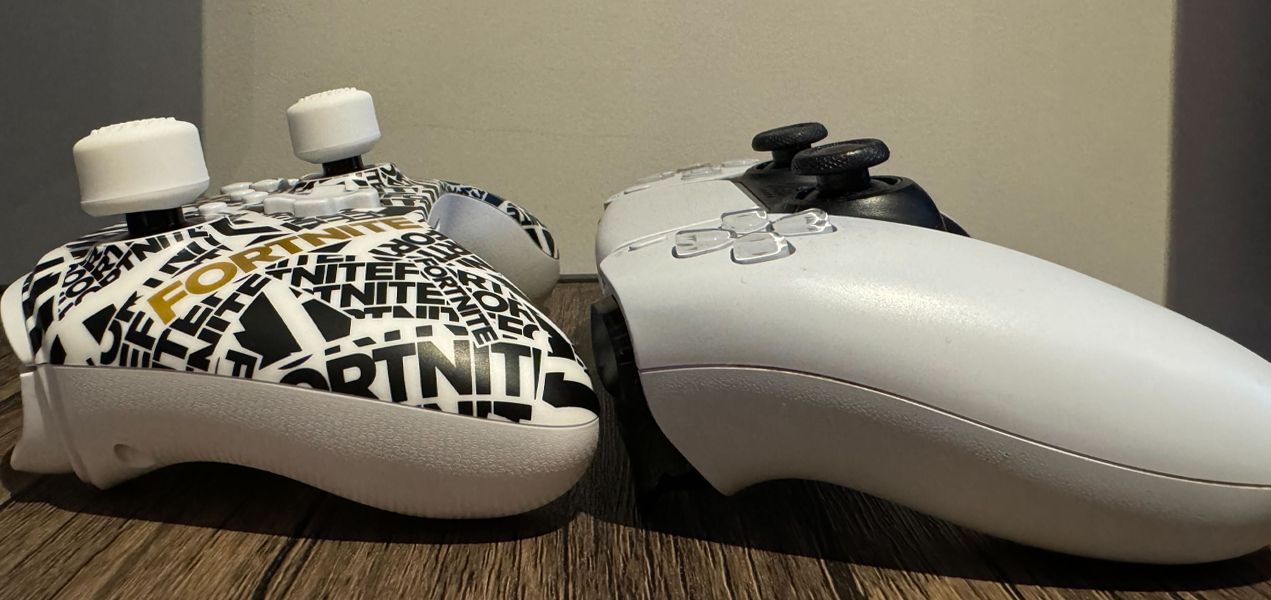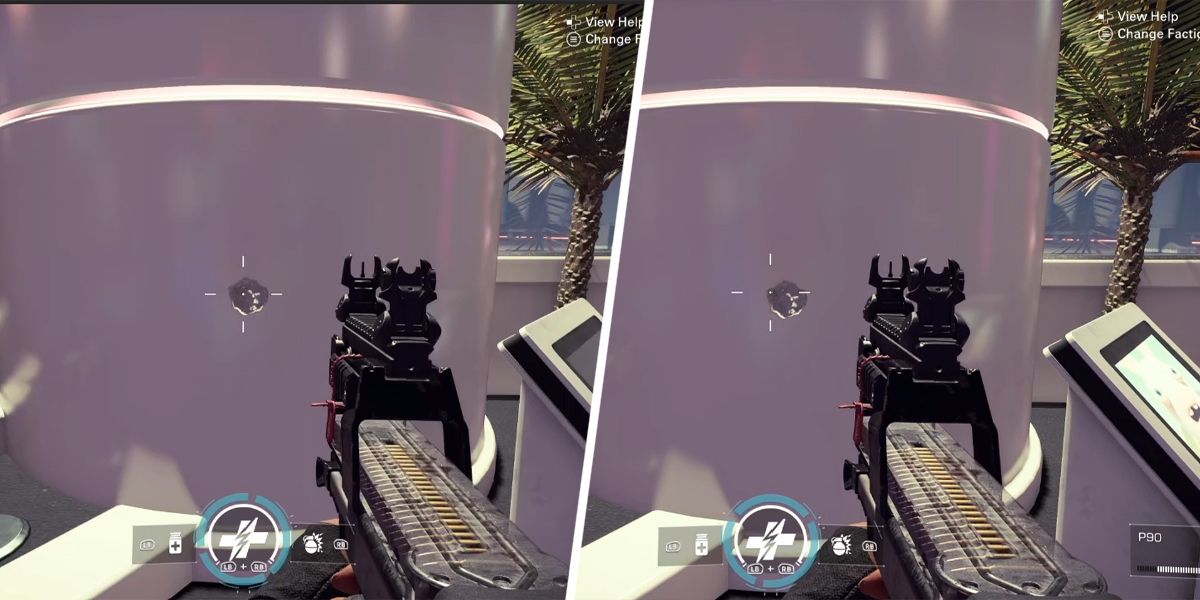
After spending countless hours with the PowerA OPS v1 controller, I find myself at a crossroads, much like a medieval knight standing before a formidable castle gate. On one hand, there are several commendable features that have captured my attention and admiration. The thumbstick caps, for instance, have proven to be both innovative and practical, enhancing my precision during gameplay. Similarly, the adjustable triggers offer a level of customization that caters to my unique preferences.
In less crowded PC controller market, gamers who prefer gamepads over keyboards and mice still have choices. Enter PowerA’s OPS line, particularly the v1 – a wireless controller designed for PC, cloud, and mobile gaming. I was fortunate enough to test the v1, assessing if it truly meets the needs of gamers seeking a controller experience that matches the precision of keyboard and mouse users.
For this review, I was sent the special Fortnite Edition of the v1, priced at $54.99/£54.99, which is just $5 more than the standard model. This puts it in the budget-friendly range compared to other PowerA controllers I’ve tested, like the Advantage, FUSION Pro Wireless, and FUSION Pro 4. Interestingly, it sits right in the same price bracket as the Xbox Core controller, which also offers great PC compatibility. So, how does the v1 measure up in the battle for your hands? Let’s find out…
- Check out the PowerA OPS v1 – Fortnite Edition here
Design
Upon opening the Fortnite Edition of OPS v1, what immediately grabbed my attention was its eye-catching, unique branding for special editions. The controller is primarily white, with “FORTNITE” emblazoned in black on the front and a metallic gold emblem on the left handle to add a touch of elegance. Additionally, the package comes with a code for the Assault Bomber Glider, as depicted below. Although these aesthetic enhancements don’t impact performance, they account for the $5 increase over the standard v1 model, so it’s worth considering if you’re debating between the two versions.

Regarding the overall controller, I’d say it feels quite comfortable and lightweight, making it perfect for long gaming sessions. While PowerA claims its weight to be about 0.593 lbs, my own measurements revealed a lighter figure of approximately 0.496 lbs, which appears to be a more accurate reflection of its true weight.
Despite lacking vibrant RGB Lumectra illumination (which I don’t mind since it typically increases cost unnecessarily), this controller boasts a textured back handle instead. It doesn’t have a rubberized finish, so it may not provide the luxurious feel you might anticipate from pricier models; however, it still excels in terms of both comfort and grip.
As for its functionalities, the OPS v1 provides three ways to connect: Bluetooth, wireless using a USB adapter at 2.4GHz, or wired via USB. I primarily used the wired and wireless modes, and they both functioned quite smoothly. Although I didn’t have an opportunity to thoroughly test the claimed battery life of up to 20 hours, I didn’t experience any battery-related problems throughout my usage period. If it ever runs out of power, recharging it is a straightforward solution.
Functionally speaking, version 1 is loaded with practical features. It includes four programmable side buttons, dual vibration motors, independent three-way lock mechanisms on the triggers, a Turbo button located at the front, Hall Effect thumbsticks and triggers, and two extra thumbstick caps (as shown) that can be swapped to adjust the height for improved precision.

Some things that stood out about the design of these features:
- The four back buttons felt significantly sturdier and more satisfying to press compared to the softer, easier-to-misclick buttons I’ve experienced on previous PowerA controllers. That said, they’re positioned quite close together, which might be a bit cramped for some users.
- The switches for adjusting trigger height on each side were notably stiff and required a fair bit of force to move. While this may sound like a downside, I appreciated it—it meant there were no accidental adjustments mid-game.
- In terms of the actual trigger height, I found the shorter distances to be, well, slightly shorter than what I experienced using the PowerA FUSION Pro Wireless, especially at the lowest setting.
- The trigger caps had a chunky, tall design with a concave surface, which initially made me hesitant. On top of that, they were pretty tough to snap on—I had to use a surprising amount of force, which made me worry about the long-term durability of the thumbsticks, especially after repeated use of putting them on and taking them off.
As a gamer, I’ve got to say, have all these new additions truly upped my gaming experience? That’s what I’m about to find out!
Performance
I’ll start by saying that I didn’t thoroughly test the Turbo button, but I can appreciate it as a handy extra feature for those who might need it. As for the dual rumble motors and wireless connection, I have no complaints. The rumble motors did exactly what they should, adding a subtle but welcome layer of immersion to gameplay, and the wireless connection was fairly solid. I experienced no more lag than usual, with inputs feeling as responsive as you’d expect. The real test, however, came from putting the controller through its paces in games like XDefiant, FC 25, and, of course, Fortnite.
To kick things off, let’s discuss the trigger locks. After experimenting, I discovered that my optimal arrangement has the right trigger set on the shortest or medium level, while the left one is at mid-distance. In this setup, I managed to win the initial game of Fortnite I ever played. My responses seemed swift, and I undeniably experienced an improvement in performance due to the trigger locks—whether it was a genuine advantage or just a psychological effect, it proved beneficial for me.
Previously, I had some reservations about the thumbstick caps, specifically concerning their height and dimensions. Yet, my concerns proved unfounded as these caps noticeably enhanced my aiming skills, particularly during fine-tuning adjustments. As a result, I experienced improved accuracy, recording an over 2.5 K/D ratio in XDefiant while sniping – a challenging test of precision, and quite an achievement for me given my average gaming abilities. Despite enjoying using both caps for balance, I believe most gamers would benefit from utilizing only one on the right stick, thereby leaving the left stick unencumbered for swifter movements.
To put it simply, even though I was thrilled with the advanced Hall Effect technology on these controllers, I’ve unfortunately noticed a persistent issue – stick drift. It’s something I’ve regrettably experienced before with several PowerA controllers. When testing them using Gamepad Tester, both sticks failed to return to their original position after being moved, causing minor yet consistent drift. During a gaming session of XDefiant, the right stick exhibited noticeable drift up and to the left without any input, as evidenced by the screenshots below (taken approximately 10 seconds apart). Although this drift didn’t always affect in-game movement, it occurred frequently enough to raise concerns.

Gladly, PowerA’s PC HQ software comes equipped with a recalibration option that momentarily readjusted my controller’s sticks for me. Yet, upon giving them another nudge, they seemed to veer ever so slightly off-center yet again.
Ultimately, Gamepad Tester found that the OPS v1’s joysticks were only slightly more precise and free from drift compared to my 3-year-old PS5 DualSense controller, which doesn’t have Hall Effect technology at all. To be honest, this fact raises some questions for me.
Software
PowerA’s PC Headquarters software serves as a versatile solution for tasks such as testing, calibrating, reassigning button functions, tweaking turbo settings, optimizing joystick sensitivity, customizing trigger behavior, and assessing rumble intensity for the OPS v1 device.
This software seems quite similar to a revamped edition of PowerA’s Gamer HQ – it’s sleeker, user-friendly, and simple to move around in. The menus are neatly arranged, and they provide straightforward guidance at every step, resulting in a more seamless experience as a whole.

Mostly, I employed the software to adjust the settings of my controller, and I discovered that it was simpler for me to configure the four rear buttons compared to the built-in method. The latter requires clicking the middle rear button, followed by the button you wish to reassign, and finally the new destination button.
You’ll see that the software interface displays “Profile 1” at the top left, but regrettably, it doesn’t seem to have an option for saving multiple profiles, which could have been quite handy. However, since PowerA’s PC HQ software is currently in BETA, there’s hope they might add profile saving in a future update.
Verdict
In summary, I find this controller somewhat elusive due to its mixed qualities. Despite some drawbacks, certain aspects such as the comfortable thumbstick caps and adjustable triggers make a strong impression on me. However, it seems that each praiseworthy feature is counterbalanced by a potential flaw, making it a bit of a challenge to fully appreciate. For example:
- It keeps things simple without overcomplicating the design, but some elements feel a bit on the cheap side.
- The four additional back buttons are solid and satisfying to press, but one could argue they’re a bit too close together for comfort.
- The thumbstick caps did improve my precision and accuracy, but they’re concave, which goes against the common belief that convex sticks are better for aiming. Plus, they require a fair amount of force to snap on, which could affect the sticks’ long-term accuracy with repeated use.
Regarding precision, the issue of stick drift is quite significant, taking into account its application with Hall Effect technology. Although the drift was negligible during my trials, it’s an issue that ideally wouldn’t arise at all and might potentially escalate in severity over time.
Considering all aspects – the advantages, disadvantages, and my personal enjoyment using it – it’s evident that this device offers a multitude of features at its price range, particularly with the standard OPS v1 option. I believe the score assigned below is reasonable. However, I would like to mention that the score might decrease by a point or two if the stick drift worsens and begins affecting gameplay in the future.
Where to buy the controller *
- PowerA – $54.99 ($49.99 for the regular controller)
- Amazon – $54.99 / £54.99
* prices are accurate at the time of writing but are subject to change
Read More
- Grimguard Tactics tier list – Ranking the main classes
- 10 Most Anticipated Anime of 2025
- USD CNY PREDICTION
- Box Office: ‘Jurassic World Rebirth’ Stomping to $127M U.S. Bow, North of $250M Million Globally
- Silver Rate Forecast
- Gold Rate Forecast
- Black Myth: Wukong minimum & recommended system requirements for PC
- Mech Vs Aliens codes – Currently active promos (June 2025)
- Maiden Academy tier list
- Hero Tale best builds – One for melee, one for ranged characters
2024-10-24 12:42